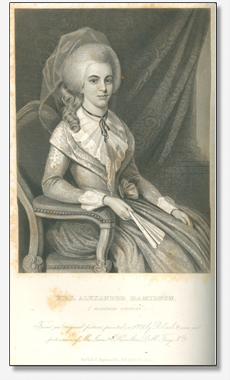
Rufus W. Griswold, The Republican Court, or, American Society in the Days of Washington. New and rev. ed. (New York,1856), plate opposite 55. First ed., 1855.
ELIZABETH SCHUYLER HAMILTON (1757-1854) Born in Albany, New York, the daughter of General Philip Schuyler and his wife Catherine Van Rensselaer, Elizabeth Schuyler was raised in Albany’s most elegant mansion. The Schuylers were one of the nation’s wealthiest families, and Elizabeth and her siblings grew up accustomed to finery and elite company. In 1779, Tench Tilghman, met Elizabeth Schuyler and wrote the following description of her:
Alexander Hamilton (1755-1804) met Elizabeth Schuyler soon thereafter, and the two were wed in December of 1780. According to Hamilton’s biographer, writing in 1858, “The bride was beautiful, accomplished, talented, and well-born. Her vivacity, intelligence, and amiability, had rendered her a universal favorite in the polished circles of Albany, at that time one of the most select and cultivated towns in the country.”[2] Hamilton had served as George Washington’s primary aide during the American Revolution, and he became one of the most important members of the new nation after its founding. During Hamilton’s multifaceted career (he was, among other things, a congressman, secretary of the treasury, a lawyer, and co-author of the Federalist Papers), he and Elizabeth resided primarily in New York City and Philadelphia. They raised eight children, and built the Grange, their country house in upper Manhattan, in 1802. Hamilton’s friendship with Washington was bolstered by that of their wives. Elizabeth (sometimes called “Eliza” or “Betsy”) was, according to Rufus Griswold, one of Martha Washington’s closest friends.[3] As the wife of one of the nation’s most prominent founding fathers and confidante to the First Lady, Elizabeth Hamilton became a familiar face in both New York and Philadelphia society. Over the course of her marriage, Elizabeth often helped her husband with his work, “counsel[ing] him in his affairs and [keeping] his papers in order for him.”[4] With her husband’s untimely death by duel, which left her to pay his large debts (he had stretched himself thin buying on credit), Elizabeth was forced to sell the Grange. She later was able to buy it back with inheritance money that she received, but she lived in a relative poverty during her fifty years of widowhood. However, her misfortunes did not keep her out of the public eye. Instead of shrinking into obscurity in the latter half of her life, Elizabeth Schuyler Hamilton worked in several charitable organizations to help orphans and the homeless. She worked first in the New York Orphan Asylum Society and later founded orphanages in New York City and Washington, D.C., where she would die at the age of 97. Written by Annie Turner. Another portrait appears in:
[1] As quoted in John Chester Miller’s Alexander Hamilton and the Growth of the New Nation (New Brunswick: Transaction Publishers, 2003), 64. [2] Samuel M. Smucker, The Life and Times of Alexander Hamilton (Philadelphia: G.G. Evans, 1858), 92. [3] Rufus W. Griswold, The Republican Court, or, American Society in the Days of Washington (New York: D. Appleton and Company, 1867), 393. [4] Appletons’ Cyclopaedia of American Biography, s.v. “Hamilton, Elizabeth Schuyler.” |

